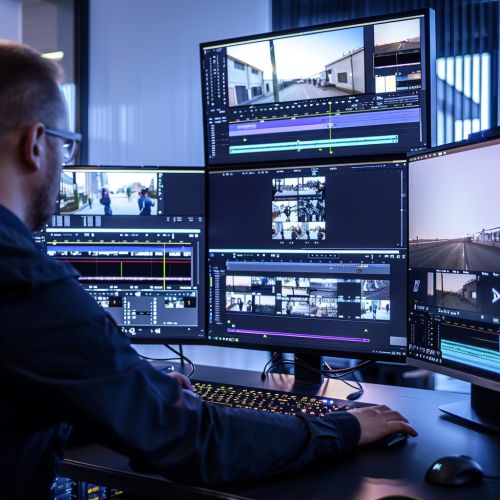Digital Video: Difference between revisions
(Created page with "== Introduction == Digital video refers to the representation of moving visual images in a digital format. Unlike analog video, which represents images using continuous signals, digital video encodes images as binary data, allowing for more efficient storage, transmission, and manipulation. The advent of digital video has revolutionized various industries, including entertainment, broadcasting, and telecommunications, by providing higher quality, greater flexibility, an...") |
No edit summary |
||
| Line 49: | Line 49: | ||
Color grading is the process of adjusting the colors and tones of a video to achieve a desired look or mood. Tools like [[DaVinci Resolve]] are widely used for professional color grading. | Color grading is the process of adjusting the colors and tones of a video to achieve a desired look or mood. Tools like [[DaVinci Resolve]] are widely used for professional color grading. | ||
[[Image:Detail-92113.jpg|thumb|center|Video editor working on a computer with multiple screens displaying video editing software.|class=only_on_mobile]] | |||
[[Image:Detail-92114.jpg|thumb|center|Video editor working on a computer with multiple screens displaying video editing software.|class=only_on_desktop]] | |||
== Digital Video Transmission == | == Digital Video Transmission == | ||
Latest revision as of 03:41, 18 June 2024
Introduction
Digital video refers to the representation of moving visual images in a digital format. Unlike analog video, which represents images using continuous signals, digital video encodes images as binary data, allowing for more efficient storage, transmission, and manipulation. The advent of digital video has revolutionized various industries, including entertainment, broadcasting, and telecommunications, by providing higher quality, greater flexibility, and enhanced capabilities.
History of Digital Video
The development of digital video can be traced back to the mid-20th century when researchers began exploring ways to digitize visual information. Early experiments in digital video were conducted in the 1960s and 1970s, but it wasn't until the 1980s that significant advancements were made. The introduction of the MPEG (Moving Picture Experts Group) standards in the late 1980s and early 1990s played a crucial role in the widespread adoption of digital video. MPEG-1, MPEG-2, and MPEG-4 standards provided the foundation for digital video compression and transmission, enabling the development of digital television, DVDs, and online video streaming.
Digital Video Formats
Digital video can be stored and transmitted in various formats, each with its own characteristics and applications. Some of the most common digital video formats include:
AVI (Audio Video Interleave)
Developed by Microsoft, AVI is one of the oldest digital video formats. It supports multiple audio and video streams and is compatible with a wide range of media players and editing software.
MP4 (MPEG-4 Part 14)
MP4 is a widely used digital video format that supports high-quality video and audio compression. It is compatible with most modern devices and platforms, making it a popular choice for online video streaming and distribution.
MKV (Matroska)
Matroska is an open-source digital video format that supports multiple audio, video, and subtitle tracks. It is known for its flexibility and ability to store high-definition content.
MOV (QuickTime File Format)
Developed by Apple, MOV is commonly used for video editing and playback on macOS and iOS devices. It supports high-quality video and audio compression and is compatible with various media players.
WMV (Windows Media Video)
WMV is a digital video format developed by Microsoft. It is optimized for streaming and is commonly used for online video content.
Digital Video Compression
Digital video compression is essential for reducing the file size of video content while maintaining acceptable quality. Compression algorithms remove redundant and non-essential information, allowing for more efficient storage and transmission. There are two main types of digital video compression:
Lossy Compression
Lossy compression reduces file size by permanently removing some data, resulting in a loss of quality. Common lossy compression formats include H.264, H.265, and VP9. These formats are widely used for online video streaming and broadcasting due to their high compression efficiency.
Lossless Compression
Lossless compression reduces file size without any loss of quality. It is typically used for archival purposes and professional video editing. Common lossless compression formats include FFV1 and HuffYUV.
Digital Video Editing
Digital video editing involves manipulating and rearranging video clips to create a final product. Modern digital video editing software offers a wide range of tools and features, including:
Non-linear Editing (NLE)
Non-linear editing allows editors to access any part of a video clip without having to follow a sequential order. This flexibility enables more efficient and creative editing processes. Popular NLE software includes Adobe Premiere Pro, Final Cut Pro, and Avid Media Composer.
Special Effects and Compositing
Special effects and compositing involve combining multiple video elements to create complex visual effects. Software such as Adobe After Effects and Nuke are commonly used for these purposes.
Color Grading
Color grading is the process of adjusting the colors and tones of a video to achieve a desired look or mood. Tools like DaVinci Resolve are widely used for professional color grading.


Digital Video Transmission
Digital video transmission involves sending video content from one location to another using digital signals. There are several methods for transmitting digital video:
Streaming
Streaming allows video content to be delivered over the internet in real-time. Services like YouTube, Netflix, and Twitch use streaming technology to provide on-demand video content to users.
Broadcasting
Digital broadcasting involves transmitting video content over the airwaves using digital signals. This method is commonly used for television broadcasting and requires digital tuners or set-top boxes to receive the signal.
Downloading
Downloading involves transferring video files from a server to a local device for offline viewing. This method is commonly used for purchasing or renting digital video content.
Applications of Digital Video
Digital video has a wide range of applications across various industries:
Entertainment
Digital video is a cornerstone of the entertainment industry, enabling the production and distribution of movies, television shows, and online content. High-definition and 4K video formats have enhanced the viewing experience, providing greater detail and clarity.
Education
Digital video is widely used in education for creating instructional videos, online courses, and virtual classrooms. Platforms like Khan Academy and Coursera leverage digital video to deliver educational content to a global audience.
Healthcare
In healthcare, digital video is used for telemedicine, surgical training, and patient education. Video conferencing tools allow healthcare professionals to consult with patients remotely, improving access to medical care.
Security
Digital video surveillance systems are used for monitoring and security purposes. High-definition cameras and advanced video analytics enable real-time monitoring and threat detection.
Future of Digital Video
The future of digital video is shaped by ongoing advancements in technology and increasing demand for high-quality content. Key trends and developments include:
8K Resolution
8K resolution offers four times the number of pixels as 4K, providing even greater detail and clarity. As 8K televisions and cameras become more affordable, the adoption of 8K content is expected to grow.
Virtual Reality (VR) and Augmented Reality (AR)
VR and AR technologies are transforming the way digital video is experienced. VR provides immersive 360-degree video experiences, while AR overlays digital content onto the real world. These technologies are being used in gaming, education, and training applications.
Artificial Intelligence (AI)
AI is being integrated into digital video workflows to automate tasks such as video editing, content recommendation, and quality enhancement. AI-powered tools can analyze video content and generate metadata, making it easier to search and organize large video libraries.
